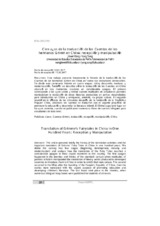Cien años de la traducción de los Cuentos de los hermanos Grimm en China: recepción y manipulación
Translation of Grimme's Fairytales in China in One Hundred Years: Reception y Manipulation

Ver/
Autor
Wang, Jinwei
Song, Yang
Editor
UCOPressFecha
2017Materia
Cuentos GrimmTraducción
Recepción
Manipulación
China
Grimms' Fairy Tales
Translation
Reception
Manipulation
METS:
Mostrar el registro METSPREMIS:
Mostrar el registro PREMISMetadatos
Mostrar el registro completo del ítemResumen
Este trabajo presenta brevemente la historia de la traducción de los Cuentos de los hermanos Grimm en China así como sus traductores destacables. Se divide esta centenaria historia en cuatro etapas: inicio, desarrollo, madurez y modernización. También se describe cómo la traducción de los Cuentos en China alcanzó en tres momentos cruciales un considerable apogeo. El primero corresponde a los años veinte y treinta cuando multitudes de estudiosos patriotas manipulaban la traducción de obras literarias producidas en países desarrollados para introducirlas en China y enriquecer, además, su propia cultura. El segundo ocurrió en la década de los cincuenta después de la fundación de la República Popular China, entonces los cuentos se traducían con el urgente propósito de promover la educación y desarrollar la literatura infantil. El último auge tuvo lugar en los años noventa, cuando se publicaron numerosos libros de cuentos bilingües para estudiantes de todo nivel. This article presents briefly the history of the translation activities and the important translators of Grimms' Fairy Tales in China in one hundred years. We divide this century into four stages (beginning, development, maturity and modernization) and analyze how the translation of the Fairy Tales reached a considerable apogee in three crucial moments in this country. The first apogee happened in the twenties and thirties of the twentieth century when multitudes of patriotic scholars manipulated the translation of literary works produced in developed countries to introduce them to China in order to enrich their own culture. The second occurred in the fifties after the founding of the People's Republic of China, then the stories were translated with the urgent purpose of promoting education and developing children's literature. The last boom took place in the nineties, when numerous bilingual story books were published for students of all levels.
